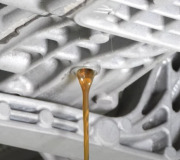It sounds like you bought a project. Any time someone says, "all it needs is, ... ", you can be sure it does not. If all it needs is a simple procedure, they would have done it so they could sell a running car for more money. They either could not do it properly them self, or they knew the job was a lot more involved than what they were telling you. I warn people against starting projects that I know will end up like this because they always end up sitting in the front yard with a "For Sale As Is" sign in the window.
Photos are always appreciated, but in this case the only thing I can see is some uneducated do-it-yourselfer slapped on an air filter that is much too small, and it is not in the correct housing with all the needed hardware that goes with it. What you need to do is start with one system, and make that complete and correct, then move on to the next system. If you look for missing stuff haphazardly, you can be sure you are going to overlook many individual things. You will have better luck finding a similar vehicle in a salvage yard that you can use for reference.
For example, start with the charging system. Be sure the generator is mounted correctly and the drive belt is in line with all the pulleys. Your generator is a GM unit and in my opinion, it's the second best design after the older Chrysler alternators. Two wires plug into the side of it. The large output wire bolted to the rear should have full battery voltage on it all of the time. One of those smaller wires will also have full battery voltage all of the time. If the "Battery" warning light on the dash turns on when you turn on the ignition switch, that second smaller wire's circuit is working. Now pick another system and approach it that way.
Perhaps the cooling system is next. Check that the radiator fan is turning the right way if it's belt-driven. This is more common when the engine uses the flat serpentine drive belts, and it's easier to do on some Ford engines, but if that belt is misrouted, the water pump can run backward. The clue may be the fan is pushing air forward, which is not correct. Do a pressure test to verify there are no leaks. Remove the upper radiator hose and inspect it inside for signs of rotting. Or just replace the radiator and heater hoses on principal.
The electrical system is done the same way, but there is many more sub-sections, like ignition system, wipers, starter, etc. If you have a crank/no-start condition, do whatever it takes to have a strong spark, then involve yourself with the fuel supply system and be sure that is doing its thing. If the engine still will not run at all, it is time to consider compression and the timing of all the events, meaning timing chain and camshaft timing. If the engine does run well for only a couple of seconds, you will know compression and timing have to be okay. Intermittent stalling involves totally different diagnosis and suspects than for an engine that never runs.
My specialty areas are electrical, suspension and alignment, and brakes. I got a real bad feeling as soon as I saw the butchered air filter. My concern is what else was done that we do not know about. If the ride height was altered, I do not even want to be part of the conversation unless it involves restoring it to factory specifications. With the brakes, there is a real lot that do-it-yourselfers can do to cause problems, and there is a real lot that professionals do during a normal brake job to avoid causing problems. Once we get the engine running, I am still going to be uneasy worrying about what we do not know that could have been modified with the brakes.
Saturday, May 13th, 2017 AT 9:01 PM








